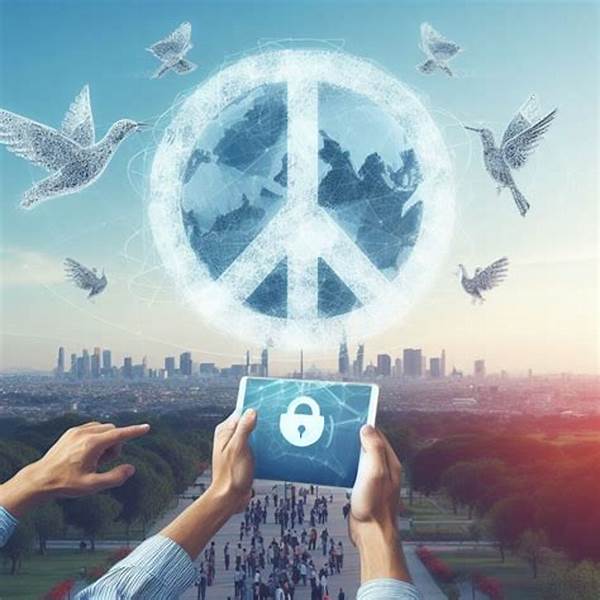The advent of advanced technologies has revolutionized various sectors, and peacekeeping is no exception. Peacekeeping technology and information sharing hold substantial potential to enhance the effectiveness, efficiency, and accountability of peace operations worldwide. These technological advancements offer novel solutions and strategies for maintaining international peace and security. They serve as pivotal tools that can facilitate the monitoring, verification, and enforcement of peace agreements, while information sharing ensures a collaborative approach among stakeholders.
The Role of Technology in Modern Peacekeeping Operations
Peacekeeping technology has become an integral part of contemporary peace operations as it enables forces to gain real-time insights and make informed decisions. Various technological tools, such as drones, satellite imagery, and advanced communication systems, provide unprecedented situational awareness. This allows peacekeepers to monitor conflict zones accurately, anticipate potential escalations, and respond promptly, thereby minimizing risks. Information sharing complements these technological tools by fostering coordination among different nations and organizations involved in peacekeeping missions. A seamless flow of information ensures transparency, promotes confidence among stakeholders, and helps in devising unified strategies to address the challenges in conflict-ridden areas efficiently. The combination of peacekeeping technology and information sharing stands as a testament to the evolving nature of peace operations in the modern era.
Benefits of Peacekeeping Technology and Information Sharing
1. Enhanced Surveillance: Peacekeeping technology facilitates advanced surveillance capabilities, ensuring real-time monitoring of conflict zones. Information sharing ensures all stakeholders have access to critical data, enhancing decision-making.
2. Improved Communication: Advanced communication systems enable efficient coordination among peacekeeping forces, and through information sharing, a comprehensive view of operations is maintained.
3. Rapid Response: With peacekeeping technology, rapid response to evolving situations is possible, supported by the timely exchange of information among peacekeeping entities.
4. Increased Efficiency: Technology optimizes resource allocation, while information sharing promotes streamlined operations, collectively enhancing the efficiency of peacekeeping missions.
5. Transparency and Accountability: Peacekeeping technology and information sharing ensure an open platform for scrutiny and evaluation, reinforcing transparency and accountability in peace operations.
Challenges in Implementing Peacekeeping Technology and Information Sharing
Despite the potential benefits, the implementation of peacekeeping technology and information sharing is not without challenges. One significant concern is the cost associated with acquiring and maintaining advanced technologies. Such expenditures can be prohibitive for many nations involved in peacekeeping missions, necessitating international cooperation and funding. Moreover, the integration of technology in diverse operational structures is complex and requires comprehensive training and adaptation of personnel to new systems. Additionally, the issue of data security and privacy in the information sharing process is paramount, as safeguarding sensitive information is crucial to maintaining trust among participating entities. Addressing these challenges requires collaborative efforts and innovative solutions tailored to different peacekeeping contexts.
Technological Innovations and Their Influence on Peacekeeping Strategies
Recent advancements in peacekeeping technology, such as artificial intelligence and machine learning, are reshaping peacekeeping strategies. These innovations offer predictive analytics capabilities, allowing for better risk assessment and planning. For instance, AI can analyze vast amounts of data to identify patterns and trends, which aids peacekeepers in anticipating conflicts and making data-driven decisions. Coupled with effective information sharing mechanisms, these technological solutions promote proactive approaches to conflict prevention. Additionally, virtual and augmented reality technologies are being explored for training purposes, offering realistic simulations for peacekeeping personnel. As these technologies continue to evolve, their integration into peace operations promises to transform traditional peacekeeping paradigms substantially.
Strategies for Effective Information Sharing in Peacekeeping
Effective information sharing is paramount to successful peacekeeping missions. Establishing standardized communication protocols and digital platforms for data exchange can significantly enhance collaboration among peacekeeping forces. The employment of secure communication channels and encryption techniques ensures the confidentiality and integrity of shared information. Training programs that emphasize the importance of information sharing and the adoption of interoperability standards are crucial in promoting a culture of openness and cooperation. Furthermore, leveraging multilateral partnerships and international networks can facilitate broader access to intelligence and insights, thereby amplifying the impact of peacekeeping initiatives.
Potential Impacts of Peacekeeping Technology and Information Sharing on International Security
The strategic use of peacekeeping technology and information sharing holds profound implications for international security. It fosters a proactive approach to conflict management, reducing the likelihood of escalation and facilitating early intervention. By enabling more comprehensive monitoring and assessment of volatile regions, peacekeeping technology provides valuable insights that inform strategic decisions. Information sharing, in turn, builds trust and unity among peacekeeping stakeholders, ensuring cohesive efforts in achieving common goals. Collectively, these elements contribute to reducing armed conflicts and enhancing global stability, underscoring the indispensable role of technology and collaboration in modern peace processes.
Conclusion
In conclusion, the integration of peacekeeping technology and information sharing represents a transformative shift in the approach to international peace operations. As peacekeeping missions continue to confront evolving challenges, the adoption of innovative technologies and strategic information sharing becomes increasingly essential. These advancements not only enhance the operational capabilities and efficiency of peacekeeping forces but also promote transparency, accountability, and collaboration. To fully realize the potential of peacekeeping technology and information sharing, continuous investment, international cooperation, and a commitment to addressing associated challenges are imperative. Through concerted efforts, the international community can foster a more effective, responsive, and sustainable framework for maintaining global peace and security.





